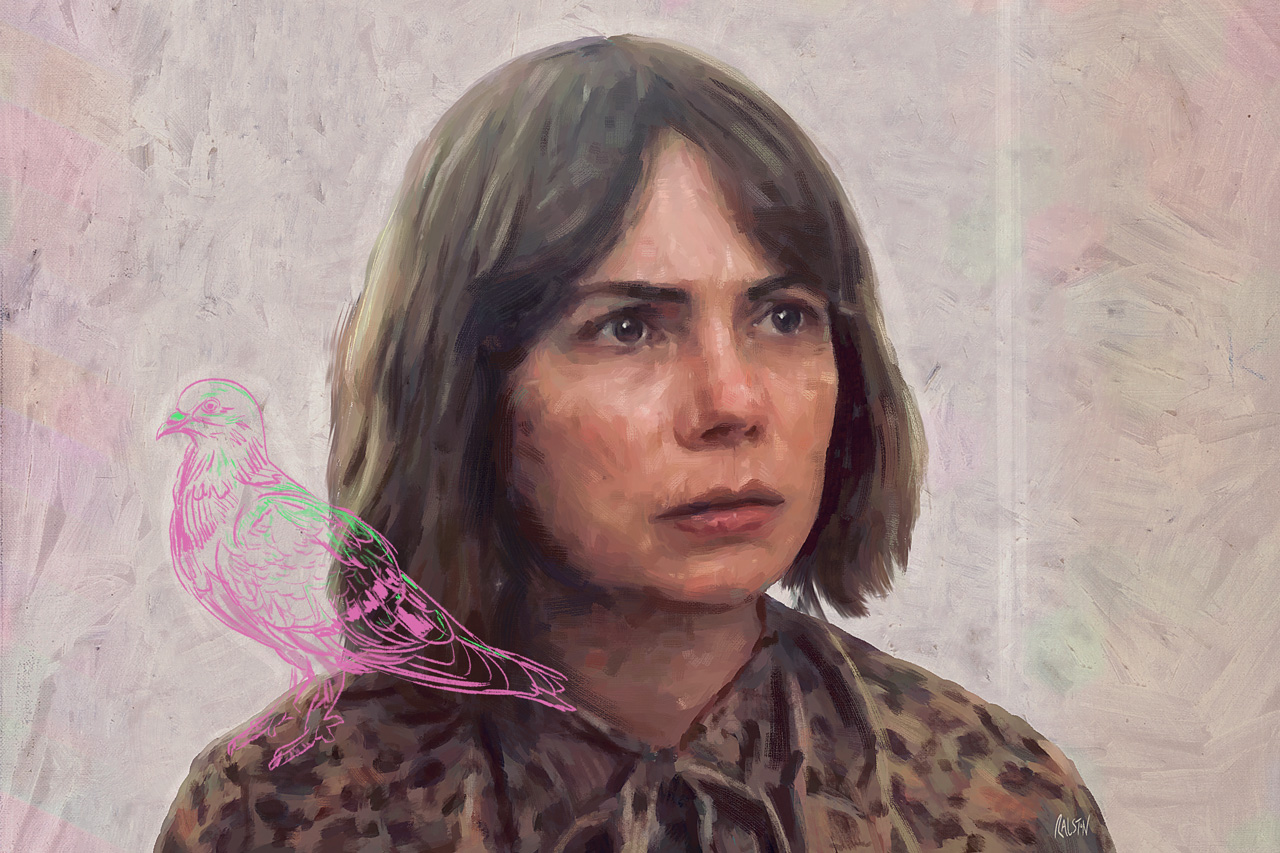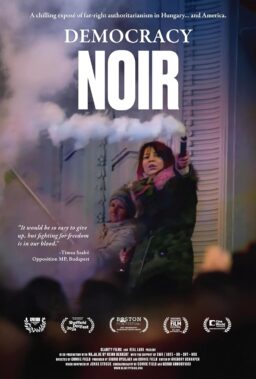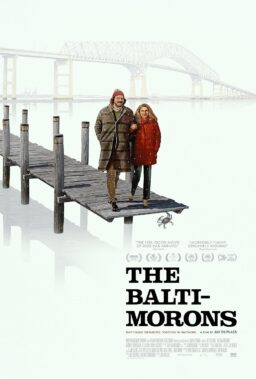We are pleased to offer an excerpt from the January 2024 issue of the online magazine Bright Wall/Dark Room. Their theme for January 2024 is “The Best of 2024,” and, in addition to Sarah Welch-Larson’s piece about “Showing Up” below, includes new essays on “Anatomy of a Fall,” “Oppenheimer,” “May December,” “La Chimera,” “Evil Dead Rise,” “Monica,” “Reality,” “Infinity Pool” and more.
You can read our previous excerpts from the magazine by clicking here. To subscribe to Bright Wall/Dark Room, or look at their most recent essays, click here.
Work is its own cure. You have to like it better than being loved.
– Marge Piercy, “For the young who want to”
“Showing Up” pays attention in the measured way that someone might stand before a painting they admire. But instead of showing the finished work, it watches the work being made: long, slow takes of an artist in her garage studio, carving away at clay. She snaps the dried-out arm off a sculpture, wincing with the break, whispers, “Sorry,” before she sculpts a new arm on. It’s the only time we’ll hear her apologize in the movie’s runtime.
“Showing Up” follows Lizzy (Michelle Williams) through the week leading up to the opening of her art show. Lizzy is a ceramicist. She makes sculptures of people in motion: gesturing, bending over to roll something, running—each one with a mysterious, lonely look in their eyes, glazed in the colors of springtime. Lizzy isn’t a major artist, and she can’t afford to live on her work. She works as an office administrator for the art college she graduated from years ago, a position that provides her with a strong tie to the local art scene, a kiln she can use to fire her sculptures, and the frustration of feeling as though she’s somehow stagnated as she watches other people move through and beyond the school. The central conflict of the film is mostly internal, as Lizzy bumps up against her building sense of dissatisfaction and need. Lizzy has a drive to create. She works hard, and she’s good at what she does. She lives for her art, and it still isn’t enough.
This situation is a recipe for resentment—of which Lizzy has stockpiled a mountain—but resentment isn’t the axis on which the film turns. Director and co-writer Kelly Reichardt weaves together a more holistic view of the world Lizzy moves through, along with the obstacles that keep her from losing herself in her garage studio. Throughout the week, Lizzy has to contend with her day job, with feeding her cat, with finding her brother Sean (John Magaro) the help he needs as he weathers his own mental health crisis. Lizzy’s hot water is out, and her landlord Jo (Hong Chau) is unhurried about fixing it. She’s caring for an injured bird (not by her own choice). She has to deal with the deepest inconvenience of all: other people. As much as Lizzy might want to shut out that cacophony of demands from the outside, she lives in a community, and she has to pay attention to the demands of living in that community in order to sustain her life and her practice.
Ugly as it is, there’s a transactional nature to the movement of our world that’s at odds with making art. Art and capitalism aren’t fully incompatible, though solving the equation in a way that doesn’t end in bankruptcy or selling out simply doesn’t work for most artists. Lizzy’s landlord Jo, an artist herself, “seems to have it figured out,” according to Lizzy. Jo makes a living renting out apartments, freeing her to throw herself into her artwork without fear of failure. Jo’s apartment building is her safety net. With it, she can afford to take artistic risks, to spend time assembling large sculptures, precisely because she doesn’t need to create her artwork in order to feed herself. She’s able to spend her time doing the thing she lives for because she’s made it inessential to her ability to support herself.
Lizzy exists in an unsolved version of Jo’s equation of art and personal finances. Lizzy’s sculptures aren’t essential to her ability to survive, because she can’t support herself by making them. But they are essential to her being. They’re the thing she builds her schedule around, the thing she worries about when she’s doing something else with her time. In the week leading up to her show, Lizzy wears a crease between her eyebrows, a frown that never goes away unless she’s in her studio sculpting. Then, the frown is replaced by concentration. All music fades away. Reichardt keeps the camera rolling in long takes throughout the movie, cutting economically, but no takes are longer than when Lizzy’s working on a sculpture. The camera doesn’t blink. It just watches as Lizzy sits absorbed in her work.
Lizzy remains so tightly focused on her own artwork that she shuts everything else out, doling out her attention elsewhere with begrudging obligation. Cinematographer Christopher Blauvelt’s camera is much more generous than Lizzy is capable of being, at least in the precious days leading up to her show. At periodic intervals, the film turns its attention to the college’s denizens. We watch students in class as they focus on their work, and see the kiln master Eric (André Benjamin) play basketball with a guest teacher named Marlene (Heather Lawless), all scored by André Benjamin’s offscreen flute playing. We spend precious minutes watching a class paint a nude model, and sit with another class intent on weaving cloth on a loom. One student brushes swaths of red color along a long yellow roll of paper; one takes a moment to check their phone in a back corner, and another considers a canvas before applying another layer of paint with a roller. Yet another class moves their bodies outside in a field in a kind of interpretive dance, their movements constituting the art they make, present and spontaneous, never to be seen again after this specific class is over. Like Lizzy, these students are each absorbed in their own work. The art school they attend fosters a space where they can work at their respective disciplines, turning their attention inward in order to channel it into some kind of art, then letting it flow outward again, until it bumps up against the real world.
The real world intrudes, and each intrusion is a different imposition on Lizzy’s time and craft. The first time Lizzy brings up the problem of the hot water to her landlord, Jo is rolling a tire down the street to make a swing, enjoying a moment of leisure in between sessions at her own studio. Jo tells Lizzy she can use her shower, a blasé offer that sounds generous, but really only makes the situation worse. Not only can Lizzy not use her own shower, she’s stuck with the indignity of being offered a shower at her landlord’s instead of the landlord just fixing the hot water. Lizzy spreads the imposition around by instead asking to use the shower at the gallery, at work, anything other than giving in to a well-meaning gesture that doesn’t give Lizzy the independence she desires.
And Lizzy is dependent on the community around her, as much as she would like to leave it behind to get her work done. Her family members—each one a unique source of exasperation and befuddlement—are the only people we see her directly invite to her show. She scavenges wood blocks for her sculpture pedestals from furniture castoffs on the side of the road in her neighborhood. She’s reliant on the kilns at the art school; she has a deal with Eric for extra space when she needs to fire her work.
Her community leaves its mark on her work, too, even when she tries to shut it out. Jo is embodied in one of Lizzy’s sculptures, a study of the moment she’d been rolling a tire down the road. Most of Lizzy’s work is informed by dashed-off watercolor studies, gestures that must have been drawn from her observations of real life, which bely her attempts to focus only on her work when she’s preparing for her show. Real life has a habit of bleeding through.
Real-world physics impose themselves on her work as well. When Lizzy brings Eric her last and largest sculpture, it ends up deep in the back of the largest kiln, crowded by other ceramics. The kiln master pulls the sculpture out after the other students have gone, and one side is scorched dark. Eric gives the sculpture a measured look, speculating that it had been placed too close to the back wall. He says he likes the imperfection when he hands it over to Lizzy, who can only blurt out that she doesn’t. She’s horrified; it’s one of the many small disasters that threatens to upend her show.
A friend of mine, when we watched the film together, observed that the scorch marks wouldn’t have been made if Lizzy’s sculpture hadn’t been fired alongside the work of the students at the school. Her art wouldn’t have turned out the same way if it had been made in a vacuum. I wouldn’t have made the connection if I’d watched the film alone. Eric’s admiration of the work doesn’t improve Lizzy’s mood, but she makes her peace with the burned sculpture by inches, unwrapping it occasionally to look at it, then positioning it alongside her other finished work as she thinks about how best to display it.
Michelle Williams plays Lizzy’s crankiness as a pressure-release valve. She’s stressed, and she’s pent up so tightly that the stress needs to escape through the cracks. Williams carries that stress in the pinched look on Lizzy’s face: a little tired, and calculating the things she needs to do in order to get through her week to the show’s opening. The exasperation comes across as petty in small doses, but layered over a series of interlocking inconveniences, it makes sense, even though the way Lizzy talks to the people around her is brusque to the point of rudeness. Despite her character’s stress, Williams plays Lizzy with a sense of generosity, giving her character enough space around her sharp edges to allow her fellow players to latch on, then launch off her in surprising directions. “Showing Up” is Williams’s movie, but she’s not the only one in it.
There’s a sense of spontaneity in the film, which stems from the performances and the measured editing. Each character feels lived-in; when Lizzy talks to her brother, her words carry a different flavor of stress and care than when she talks to her dad (Judd Hirsch). There are no histrionics, but there are the surprises that come with fully-formed characters. When Lizzy’s brother digs up his backyard in a manic bout, Lizzy watches him with concern, but quips, “I didn’t know you did earth work,” a nod to the art world that the two of them grew up in, and a gentle joke that probes his state of mind without coming out and asking him directly about what he’s going through. The spontaneity of Lizzy’s day-to-day is stitched together by the intercut scenes of students in class at the art college, each one placing their own artistic mark on the film through their practice.
One teacher (James Le Gros) even calls out the value of surprise in his own work. “There’s spontaneity in that pot. It’s its own thing,” he says, as he passes a vase around a circle of students. The sentiment applies to all of the art in the film: the way Lizzy intends for her sculptures to turn out from the kiln is different from how they actually end up, especially in the case of the burned sculpture. And the way that Lizzy’s work is received is also different from the way that Lizzy expects her work to be received. Success, in her eyes, is the sculpture not breaking when it cools; her smaller sculptures coming out of the kiln looking exactly as she’d planned doesn’t do anything to alleviate her stress about the show coming together. The scorched sculpture was intended to be the focal point of Lizzy’s show. In the scorching, it becomes the focal point on which the movie turns, too.
What matters is the work, but the work isn’t the only thing that matters. Art is, by alternating definitions, both useless and essential. It isn’t necessary for the base layers on Maslow’s hierarchy. But if it were entirely useless we wouldn’t spend so much time making it, and thinking about it, and so on. It’s important; it isn’t the only thing. But it adds color and texture and life to the world, just as the world adds color and texture and life to it.
At the art show, the camera gets a good long look at Lizzy’s ceramics on their plinth, then studies her father’s face as he makes his circle around the room, drinking everything in. This is the turning-out moment, the unclenching from Lizzy’s extreme inward focus as she tries to complete the art for her show on time. Lizzy makes the work for herself, because she has to. She never explains that motivation, because the film takes her need to create something completely for granted. It doesn’t need a reason to exist. It’s made worthwhile in the making, and it’s made worthwhile by the delight it brings to the people who see it. Lizzy’s father—a retired ceramicist himself—is pleased by the work he sees. “You were daring with the colors!” he remarks. She’s surprised him with her art.
Lizzy’s fighting the burden of expectation throughout the film. She expects the world to be a certain way; she expects the hot water to work and her day off to be artistically productive, and she expects her glazes to come out of the fire at just the right shade. The hot water doesn’t get fixed. (When Jo, preparing for a show of her own, complains that there might not be a catalog to go with the exhibit, Lizzy snipes back: “Things usually get done, just not on time.”) Family emergencies keep cropping up. Lizzy and Jo take joint care of an injured pigeon, another distraction to add to Lizzy’s pile of grievances, another thing to take her away from her work. The pigeon had always been there—the film’s soundtrack includes the bird burbling just outside Lizzy’s studio right from the beginning. She resents it at first, then slowly takes on a feeling of ownership about the bird’s care, telling Jo how best to change the newspapers out of its box. Late one night in the studio, as she eats chips and dissociates, Lizzy reaches over to lightly scritch the bird on its head. Sometimes we make peace with our distractions. Sometimes they add unsearched-for texture to the movements of our imaginations.
When the bird finally takes flight at the end of the film, it flaps circles around Lizzy’s ceramics. The bird had threatened her ability to complete her work before the show, simply by nature of being a helpless animal in need. Now that she’s made peace with it, it could be a physical threat to her work. Reichardt treats the pigeon’s surprise flight as a moment of shock, then of startling possibility. Lizzy’s brother picks it up off the floor, his movements gentle as he carries it outside to where it belongs. Lizzy doesn’t get the chance to say goodbye before the bird takes off again. She can only follow and watch in wonder as her handiwork moves above her head, out of reach, healthy and free. There’s spontaneity in that pot.











